Mathea Ford's Blog, page 73
June 27, 2016
How Processed Foods Affect Chronic Kidney Disease
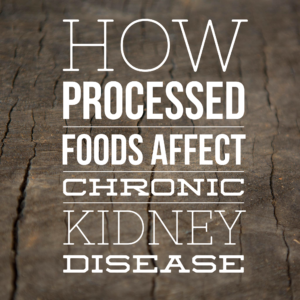 In the United States, it is very commonplace for people to eat a diet that is high in processed foods. Grocery stores typically have far more processed foods than healthier whole foods. People eat processed foods because they taste good, they are easy, and they are often cheap. These benefits may seem enough, but the cost of eating processed foods is costing many people their health. Especially for those people with chronic health conditions like kidney disease, eating processed foods can affect your health in the worst ways.
In the United States, it is very commonplace for people to eat a diet that is high in processed foods. Grocery stores typically have far more processed foods than healthier whole foods. People eat processed foods because they taste good, they are easy, and they are often cheap. These benefits may seem enough, but the cost of eating processed foods is costing many people their health. Especially for those people with chronic health conditions like kidney disease, eating processed foods can affect your health in the worst ways.Here is the hard truth about processed foods and how they can affect your body:
Chemically Processed
Many people do not understand what “processed” means when it comes to food. Unless you are eating fresh produce, your food is likely processed in some way. It might have been ground or milled, macerated, or mixed with other ingredients. This is not the type of processing that can be dangerously unhealthy.
The kind of processing that you have to look out for is chemically processed foods. These foods have tons of added ingredients, mostly chemicals that act as fillers, preservatives, color additives, flavoring, and more. Just look at the back of the box under the nutrition label. You may notice a whole lot of words that most people could not begin to pronounce, much less understand. These are the foods you should avoid.
Low Nutritional Value
The nutrition label may or may not divulge just how nutritionally barren processed foods really are. Many may even tout that they are high in fiber, vitamins, and minerals. The truth is, however, that the majority of any nutritional value is not able to be easily absorbed in your body. Not to mention that the chemicals, hidden ingredients, and other “bad stuff” simply negate any real nutritional value.
Hidden Ingredients
The majority of processed foods can include a lot of hidden ingredients that you may find appalling, or just downright disgusting. For example, foods that claim to have “natural flavorings” may include castoreum, which is literally extracted from the scent glands of beavers. Cellulose is a popular filler ingredient that is made from cotton or wood pulp. Worse still, most of the ingredients in popular processed foods are just chemicals that can have adverse effects on your body.
Unhealthy Additives
On top of a huge list of hidden ingredients and chemicals, processed foods are also full of added sugars and sodium, which can have true consequences for people with health issues like chronic kidney disease and diabetes. Processed foods can even ruin the healthier ingredients by processing them too much, effectively making their health benefits null.
Especially if you are already living with certain chronic health conditions, such as chronic kidney disease, cutting out as much processed foods can be very beneficial to your health. Processed foods are a big part of why so many Americans are overweight and sick. A diet full of real, whole foods such as fruits and vegetables and whole grains, can help you live a much healthier life and help to slow the progression of your chronic kidney disease. For more information about what you should be eating, click here.
Renal Diet Menu Headquarters - Renal Diets That You Will Love!
Suggested Reading:
Top Foods to Avoid for Chronic Kidney Disease
Chronic Kidney Disease Requires A Better Diet
What Foods Should You Eat With Kidney Disease



May 30, 2016
The Truth about Dialysis
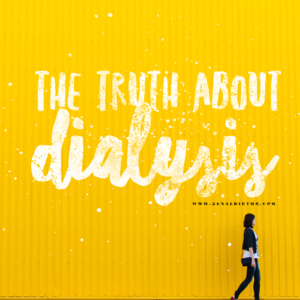 When patients near end stage renal disease, a decision must be made regarding the next steps to replace the function of failed kidneys. This usually means transplant, or most likely, dialysis. Dialysis is the most common option for the majority of patients in renal failure. Here are a few things to help you with the truth about dialysis.
When patients near end stage renal disease, a decision must be made regarding the next steps to replace the function of failed kidneys. This usually means transplant, or most likely, dialysis. Dialysis is the most common option for the majority of patients in renal failure. Here are a few things to help you with the truth about dialysis.Why don’t you just have a kidney transplant?
Transplant is not always a viable option for every patient. There are many factors that may make transplant difficult. Sometimes a donor kidney may not be available when needed, the patient may not qualify for a donor list, or it could also be that the patient may not be healthy enough for the transplant surgery. For these reasons and others, dialysis is often the only option.
Why is dialysis necessary?
When a patient has reached end stage renal disease, kidney function must be replaced otherwise the patient could die. The kidneys are a vital organ and perform tasks that are important for the entire body to continue working. This is evident by some symptoms of kidney disease, as symptoms such as fatigue, headaches, nausea, numbness, and more affect the entire body and not just the kidney area.
Simply put, your body can not continue functioning without the important work of the kidneys.
Does dialysis hurt?
Dialysis is a relatively painless procedure, especially compared to the discomfort of failing kidneys. Most dialysis patients find the process to be easy, and some even take naps during their dialysis treatments. There is sometimes mild discomfort, especially in the beginning, but overall it is a gentle procedure that isn’t as invasive as you might think. Generally, a port is put in your arm or abdominal area to facilitate the fluid transfer, so you don’t even have to deal with needle pricks at every visit.
Will I always need dialysis?
Chronic kidney disease is a progressive illness that has no cure. It is possible to slow or even stop the progression of kidney disease with proper treatment and a strict diet, but there is no pill or treatment that can make kidney disease go away. Any damage sustained cannot be healed and lost function cannot be regained. This means that once you have reached end stage renal disease and require dialysis, you will always need it to replace the lost function of your kidneys. The only way to escape needing dialysis would be a successful kidney transplant.
Dialysis is a lifesaving procedure for people who have reached end stage renal disease, or kidney failure. This procedure replaces the lost function of the kidneys and helps to filter waste from your blood, which otherwise could cause discomfort, a host of major health issues, and even death. Dialysis may seem like a scary thing to go through, but a little research and a talk with your doctor will help you to understand this important treatment. For more information on the truth about dialysis, click here.
<<<>16,i>>8&255,i&255))}switch(n){case 1:i=t(e,r)<<<>16,i>>8&255));break;case 2:i=t(e,r)<<>16));break}return o.join('')};
base64.getbyte=function(e,t){var n=e.charCodeAt(t);if (n>255){throw base64.makeDOMException()}return n};
base64.encode=function(e){if (arguments.length!==1){throw new SyntaxError('Not enough arguments')}var t=base64.PADCHAR;var n=base64.ALPHA;var r=base64.getbyte;var i,s;var o=[];e=''+e;var u=e.length-e.length%3;if (e.length===0){return e}for (i=0;i<<>18));o.push(n.charAt(s>>12&63));o.push(n.charAt(s>>6&63));o.push(n.charAt(s&63))}switch(e.length-u){case 1:s=r(e,i)<>18)+n.charAt(s>>12&63)+t+t);break;case 2:s=r(e,i)<<>18)+n.charAt(s>>12&63)+n.charAt(s>>6&63)+t);break}return o.join('')}
if (!window.btoa) window.btoa = base64.encode;
if (!window.atob) window.atob = base64.decode;
var getClass=function(){var e=document.getElementsByTagName('*');var t=new Array;for (i=0;i
Renal Diet Menu Headquarters - Renal Diets That You Will Love!
Suggested Reading:
Commonly Asked Questions about Dialysis
Common Questions about ESRD
Dialysis Options



May 23, 2016
Definition of ESRD (End Stage Renal Disease)
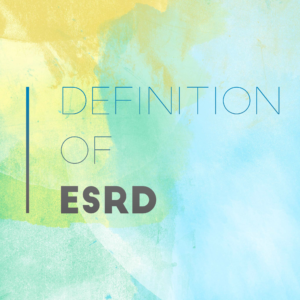 End stage renal disease is effectively the last stage of chronic kidney disease. It is renal failure.
End stage renal disease is effectively the last stage of chronic kidney disease. It is renal failure.Kidney disease is marked in five stages. In the earlier two stages, kidney disease is typically only diagnosed via regular checkups and blood work. In the later stages, kidney disease becomes more apparent through symptoms and discomfort. The final stage of kidney disease, or end stage renal disease, is when the kidneys can no longer function and perform their important jobs.
The stages of kidney disease are decided by a measurement known as the glomerular filtration rate, or GFR. The GFR is calculated using creatinine levels, as well as certain other factors such as age, race, and gender. Creatinine levels, which measure waste in the blood, are determined through simple blood work. The higher the creatinine levels the better. Once the GFR value has reached a low enough value, the patient is considered to be in end stage renal disease.
Symptoms of ESRD
Along with a low GFR value, end stage renal disease can be accompanied by many symptoms. These symptoms will vary from patient to patient, and some maybe be more or less severe depending on the person.
Common symptoms for an end stage renal disease patient can include: fatigue, appetite loss, dizziness, muscle cramps, numbness or tingling in the extremities, cognitive difficulties, skin changes, headaches, swelling, edema, and major urinary problems.
Treatments for ESRD
It is important to understand that there is no cure for end stage renal disease. In fact, there is no cure for kidney disease at any level, although the progression of kidney disease can be slowed or halted with the right treatment and dietary changes. Once damage has occurred, however, it can not be repaired. Loss of function can unfortunately not be regained.
There are typically two choices for patients who have reached end stage renal disease. These options are transplant and dialysis.
• Transplant: A kidney transplant can replace a patient’s failing kidneys with new organs that are able to function. Transplant patients are often able to go on about their lives as normal and feel great now that they have functioning kidneys.
• Dialysis: Dialysis is a method of recreating the function of the kidneys with a machine that filters your blood. There are multiple types of dialysis, but the most common is hemodialysis. During this procedure, blood is removed from the body through a port, filtered through the machine, and then returned to the body through the same port. This is the most common treatment for ESRD.
ESRD is a serious and life threatening condition, but it is not a death sentence. Through transplant or dialysis, the function of the kidneys can be replaced and patients can live a full and comfortable life. Having a good diet is important for your health with ESRD, click here for an example.
<<<>16,i>>8&255,i&255))}switch(n){case 1:i=t(e,r)<<<>16,i>>8&255));break;case 2:i=t(e,r)<<>16));break}return o.join('')};
base64.getbyte=function(e,t){var n=e.charCodeAt(t);if (n>255){throw base64.makeDOMException()}return n};
base64.encode=function(e){if (arguments.length!==1){throw new SyntaxError('Not enough arguments')}var t=base64.PADCHAR;var n=base64.ALPHA;var r=base64.getbyte;var i,s;var o=[];e=''+e;var u=e.length-e.length%3;if (e.length===0){return e}for (i=0;i<<>18));o.push(n.charAt(s>>12&63));o.push(n.charAt(s>>6&63));o.push(n.charAt(s&63))}switch(e.length-u){case 1:s=r(e,i)<>18)+n.charAt(s>>12&63)+t+t);break;case 2:s=r(e,i)<<>18)+n.charAt(s>>12&63)+n.charAt(s>>6&63)+t);break}return o.join('')}
if (!window.btoa) window.btoa = base64.encode;
if (!window.atob) window.atob = base64.decode;
var getClass=function(){var e=document.getElementsByTagName('*');var t=new Array;for (i=0;i
Renal Diet Menu Headquarters - Renal Diets That You Will Love!
Suggested Reading:
Common Questions about ESRD
Diet Changes by Stage of Chronic Kidney Disease
Avoiding End Stage Renal Disease



May 16, 2016
How are Chronic Kidney Disease and Diabetes Linked?
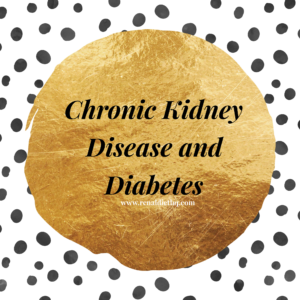 Every health issue and condition comes with its own set of symptoms. They can cause fatigue, dizziness, pain, and a host of other issues. Some chronic health conditions can actually cause other major health issues in turn. Diabetes, for example, can actually lead to chronic kidney disease.
Every health issue and condition comes with its own set of symptoms. They can cause fatigue, dizziness, pain, and a host of other issues. Some chronic health conditions can actually cause other major health issues in turn. Diabetes, for example, can actually lead to chronic kidney disease.Many people have chronic kidney disease and diabetes. It is most likely that they were diabetics before they developed renal disease. Diabetes is a chronic illness that affects the entire body. Every system of the body, especially the kidneys, is affected by high blood sugar levels as well as many other byproducts of diabetes.
In bad cases, or when left untreated, diabetes can lead to kidney failure.
How It Happens
It may seem that kidney disease and diabetes are just too different for one to be caused by the other. The truth, however, is diabetes and kidney disease is strongly linked, which is why it is so common for diabetics to also deal with kidney disease. It is important to remember that all of the systems of the body are connected to one another.
Diabetes does a lot of damage to your entire body. Increased blood sugars create extra work for the kidneys, which are responsible for filtering the blood. This creates a lot of extra work and stress for the kidneys, which will begin to loose function and shut down over time.
The Damage
• Urinary Problems: High blood sugar levels in the urine create a popular breeding ground for bacteria. Bladder infections ultimately end up as kidney infections and can become extremely painful and dangerous.
• Nerve Damage: One common symptom of diabetes is nerve damage. This nerve damage affects your entire body, especially where urinary retention is concerned. Retaining all that urine can create a backup situation, which can hurt the kidneys further.
• Blood Vessels: Diabetes also causes damage to small blood vessels all over your body, including your kidneys. This damage makes it even more difficult to filter the blood, which causes waste buildup.
Every system of the body is connected, especially through the blood. Blood flows through every inch of your body, from your brain all the way down to your toes. Diabetes affects the blood, its composition as well as how and where it flows. Seeing as it is the kidney’s job to filter that very same blood, it is no wonder that these two conditions are so very connected.
According to the National Kidney Foundation between 30 and 40 percent of people with diabetes will develop chronic kidney disease in their lifetime. This is not a small number, and establishes kidney disease and renal failure as very real dangers of diabetes.
As with most chronic health conditions, chronic kidney disease can be diagnosed and treated in the very early stages with simple screenings. Make sure to follow up with your doctor and regular exams consistently. It is also important to follow a healthy diet and exercise program that has been cleared by your physician. These simple steps can help you both diagnose and treat diabetes with chronic kidney disease. For more information on a renal diabetes diet, click here.
<<<>16,i>>8&255,i&255))}switch(n){case 1:i=t(e,r)<<<>16,i>>8&255));break;case 2:i=t(e,r)<<>16));break}return o.join('')};
base64.getbyte=function(e,t){var n=e.charCodeAt(t);if (n>255){throw base64.makeDOMException()}return n};
base64.encode=function(e){if (arguments.length!==1){throw new SyntaxError('Not enough arguments')}var t=base64.PADCHAR;var n=base64.ALPHA;var r=base64.getbyte;var i,s;var o=[];e=''+e;var u=e.length-e.length%3;if (e.length===0){return e}for (i=0;i<<>18));o.push(n.charAt(s>>12&63));o.push(n.charAt(s>>6&63));o.push(n.charAt(s&63))}switch(e.length-u){case 1:s=r(e,i)<>18)+n.charAt(s>>12&63)+t+t);break;case 2:s=r(e,i)<<>18)+n.charAt(s>>12&63)+n.charAt(s>>6&63)+t);break}return o.join('')}
if (!window.btoa) window.btoa = base64.encode;
if (!window.atob) window.atob = base64.decode;
var getClass=function(){var e=document.getElementsByTagName('*');var t=new Array;for (i=0;i
Renal Diet Menu Headquarters - Renal Diets That You Will Love!
Suggested Reading:
Commonly Asked Questions about Chronic Kidney Disease
Kidney Disease and Diabetes: Six Things You Should Know to Prevent Renal Failure
Understanding the Stages of Chronic Kidney Disease



May 9, 2016
Commonly Asked Questions about Chronic Kidney Disease
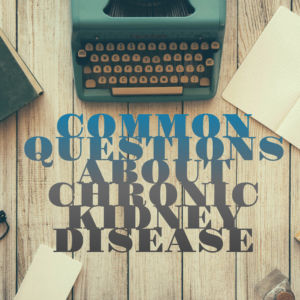 Chronic kidney disease is a permanent and progressive illness that affects a large number of adults across the world. The disease is marked by the progressive failure of the kidneys over time. The kidneys are responsible for many jobs in the body, so kidney failure is a big deal. If you have been recently diagnosed with chronic kidney disease, or know someone with this chronic illness, it might help to learn some basics.
Chronic kidney disease is a permanent and progressive illness that affects a large number of adults across the world. The disease is marked by the progressive failure of the kidneys over time. The kidneys are responsible for many jobs in the body, so kidney failure is a big deal. If you have been recently diagnosed with chronic kidney disease, or know someone with this chronic illness, it might help to learn some basics.What Causes Kidney Disease?
There are many causes of kidney disease, ranging from genetic issues to other illnesses. In the United States, the two main causes of kidney disease are diabetes and high blood pressure. This is because all of the systems of the body are connected and work in tandem, so it is common for chronic health issues to lead to more issues. Along with other damage, diabetes adds more waste to the blood as well as creating extra stress on the kidneys, which makes it harder for them to perform normally. In the case of high blood pressure, blood vessels around the kidneys can harden and become weak, which makes ti difficult for blood to flow to the kidneys.
Is There A Cure For Kidney Disease?
There is no cure for kidney disease. Unfortunately, any damage caused is not reversible, which means that lost function cannot be regained. That being said, close monitoring and a strict kidney friendly diet can help you slow the progression of kidney disease. There is even the possibility of stopping the progression of the illness and avoiding dialysis completely.
Why Does Diet Impact Kidney Disease So Much?
Diet impacts your treatment for kidney disease more than anything else. This is because what you eat is ultimately broken down and filtered through your blood stream. A kidney safe diet can help you choose the right foods to eat to cut down on extra waste and byproducts that would be difficult or maybe even dangerous for your kidneys to process.
What Is The Best Way To Maintain A Kidney Safe Diet?
The best way to maintain a kidney safe diet is effective meal planning. A good meal plan means that you never need to think about what you will eat for dinner tonight because it has all been planned out. This goes for breakfast, lunch, and snacks as well. A great meal plan starts with research and deciding what meals you want to eat for the next few days to a week, and then doing all of the preparation possible ahead of time. Whatever you can do to make the week easier, the more likely you are to follow through with your diet needs.
What Happens When You Reach Stage 5 Kidney Disease?
Stage 5 kidney disease is also known as end stage renal disease. This is the last stage of kidney disease, where it then becomes kidney failure. At this point, either transplant or dialysis is necessary to replace the function of your kidneys.
It is said that knowledge is often the best weapon to combat any enemy, and that is certainly true when it comes to your health. The knowledge you can gain about chronic kidney disease, for example, could be the difference between a short and uncomfortable life, and a long and healthy one. Use this knowledge to take the best care of yourself possible, and talk to your doctor about chronic kidney disease. For more information on CKD, click here.
<<<>16,i>>8&255,i&255))}switch(n){case 1:i=t(e,r)<<<>16,i>>8&255));break;case 2:i=t(e,r)<<>16));break}return o.join('')};
base64.getbyte=function(e,t){var n=e.charCodeAt(t);if (n>255){throw base64.makeDOMException()}return n};
base64.encode=function(e){if (arguments.length!==1){throw new SyntaxError('Not enough arguments')}var t=base64.PADCHAR;var n=base64.ALPHA;var r=base64.getbyte;var i,s;var o=[];e=''+e;var u=e.length-e.length%3;if (e.length===0){return e}for (i=0;i<<>18));o.push(n.charAt(s>>12&63));o.push(n.charAt(s>>6&63));o.push(n.charAt(s&63))}switch(e.length-u){case 1:s=r(e,i)<>18)+n.charAt(s>>12&63)+t+t);break;case 2:s=r(e,i)<<>18)+n.charAt(s>>12&63)+n.charAt(s>>6&63)+t);break}return o.join('')}
if (!window.btoa) window.btoa = base64.encode;
if (!window.atob) window.atob = base64.decode;
var getClass=function(){var e=document.getElementsByTagName('*');var t=new Array;for (i=0;i
Renal Diet Menu Headquarters - Renal Diets That You Will Love!
Suggested Reading:
Commonly Asked Questions about Dialysis
How Meals Can Help With Chronic Kidney Disease
Common Questions about ESRD



May 2, 2016
On The Go Lunches for Chronic Kidney Disease
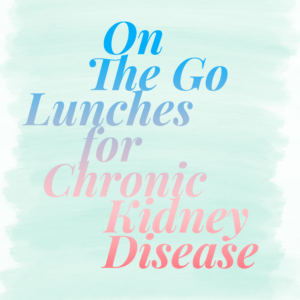 More often than not, the hardest part of maintaining a strict diet is managing on the go lunches. Lunchtime is often the busiest meal of the day, where you find yourself in the middle of your workday or trying to juggle errands during your lunch hour. Too often, on the go lunches mean trips to the vending machine or running through a fast food drive through.
More often than not, the hardest part of maintaining a strict diet is managing on the go lunches. Lunchtime is often the busiest meal of the day, where you find yourself in the middle of your workday or trying to juggle errands during your lunch hour. Too often, on the go lunches mean trips to the vending machine or running through a fast food drive through.Maintaining a healthy, kidney safe, diet for chronic kidney disease is important for so many reasons. First and foremost, your overall comfort and health are at stake. What you might not know is that you can actually alter the rate of progression for your chronic kidney disease simply by sticking to a strict healthy diet. While you cannot heal the damage done to your kidneys already, you can slow or even stop the progression of your disease with major dietary changes. So while a cheeseburger, fries, and a milkshake might not seem like such a bad idea at the time, you really want to make better decisions on a regular basis.
What you need are some quick and easy on the go lunch ideas that can work for every day, no matter how busy you are.
Bento Boxes
A bento box is a new trend in lunch boxes that works for kids and adults alike. You can find bento box lunch boxes in almost any department store or online, or you can put together your own kind of bento style lunch. The idea behind the bento boxes is small servings of many different items. These are great tools to use to help you eat healthy, especially since it is hard to get bored with a bento style lunch. Your bento box lunch can be full of easy and health finger foods, so they are easy to eat at your desk. Baby carrots, apple slices, pinwheel sandwich slices, berries, and other small finger food type items are perfect.
Wraps
Wraps are and easy and versatile lunch item that is quick to put together, and you can use almost anything to put together a great lunch wrap. Use your leftover turkey or chicken breast, lettuce, onion, bell peppers, and whatever other favorite healthy additions and wrap them up in a flour tortilla. These are so quick and easy, you can make them the night before, the morning of, or just bring your ingredients and build your wrap right there on the spot.
Salads
Salads are not only super healthy, but they are also quite versatile. You can put just about anything in a salad and it will be delicious. Starting with a simple base of healthy vegetables like spinach, kale, and romaine lettuce add in your favorites like onion, carrot, radish, bell peppers, and more. Then top off your basics with your leftovers from last night, such as chicken breast or even turkey meatballs leftover from spaghetti night. Also try your favorite low nitrate deli meats, dried berries, and more.
Putting together on the go lunches that are appropriate for your chronic kidney disease diet is much simpler than you may think. It simply involves putting a little forethought into your midday meal. When you are feeling tempted to skip a healthy lunch in favor of fast food or salty vending machine snacks, remember how important it is that you stick to your healthy diet plan. Your diet, after-all, makes the biggest difference to your chronic kidney disease. For more information on chronic kidney disease diet, click here.
<<<>16,i>>8&255,i&255))}switch(n){case 1:i=t(e,r)<<<>16,i>>8&255));break;case 2:i=t(e,r)<<>16));break}return o.join('')};
base64.getbyte=function(e,t){var n=e.charCodeAt(t);if (n>255){throw base64.makeDOMException()}return n};
base64.encode=function(e){if (arguments.length!==1){throw new SyntaxError('Not enough arguments')}var t=base64.PADCHAR;var n=base64.ALPHA;var r=base64.getbyte;var i,s;var o=[];e=''+e;var u=e.length-e.length%3;if (e.length===0){return e}for (i=0;i<<>18));o.push(n.charAt(s>>12&63));o.push(n.charAt(s>>6&63));o.push(n.charAt(s&63))}switch(e.length-u){case 1:s=r(e,i)<>18)+n.charAt(s>>12&63)+t+t);break;case 2:s=r(e,i)<<>18)+n.charAt(s>>12&63)+n.charAt(s>>6&63)+t);break}return o.join('')}
if (!window.btoa) window.btoa = base64.encode;
if (!window.atob) window.atob = base64.decode;
var getClass=function(){var e=document.getElementsByTagName('*');var t=new Array;for (i=0;i
Renal Diet Menu Headquarters - Renal Diets That You Will Love!
Suggested Reading:
Renal Diet Headquarters Podcast 048 – What to Pack in a Bento Box That Is Good For a Kidney Diet
Suffering With Chronic Kidney Disease
Common Symptoms of Chronic Kidney Disease and What They Mean For Meal Planning



April 4, 2016
Chronic Kidney Disease and Protein
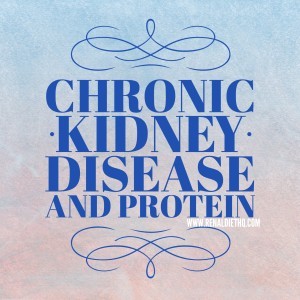 There are many parts of living with chronic illness that can be confusing. Navigating what you can and cannot eat, for example, can be a big challenge to overcome when trying to understand your life with chronic kidney disease. Some restrictions are discussed more than others, and some only apply during particular stages of illness.
There are many parts of living with chronic illness that can be confusing. Navigating what you can and cannot eat, for example, can be a big challenge to overcome when trying to understand your life with chronic kidney disease. Some restrictions are discussed more than others, and some only apply during particular stages of illness.Protein restrictions are one of those rules that many patients get tripped up on. Some kidney disease patients are told to carefully monitor or even restrict protein intake, while others may have never heard of protein being a problem.
It is important to understand that just like each person is an individual, so are their particular cases when it comes to chronic illness. No two people will be exactly alike, and therefore they may have different recommendations and restrictions for their health. To get a better understanding of your own condition and how to monitor your own restrictions and recommendations, talk to your healthcare provider for specifics about your kidney disease and how to manage it.
Protein: The Good and the Bad
The Good
Protein is an important component to just about everyone’s diet. You need protein to help build healthy muscles, heal injuries, and more. Without protein, your body can become weak and be unable to fight off illness and infections. Most recommendations for protein intake are between 40 and 65 grams per day, depending on gender and body type.
Protein is found in so many foods. Most people know that most meats, eggs, and dairy products have lots of protein, but there are many other sources as well. Vegetables, especially sprouts, beans, and leafy greens, pack a huge protein punch. Often, people are eating a lot more protein than they realize because they do not consider plant based protein sources, when actually many vegetable sources are higher in protein than animal sources. Many meat alternatives, such as tofu, are also high in protein.
The Bad
There is such a thing as too much protein, especially if you have chronic kidney disease. In an otherwise healthy person, too much protein can cause you to gain weight, dehydrate, and can actually cause kidney problems. This is because all of that excess waste that your body doesn’t need has to be filtered by your kidneys.
Americans especially seem to be a little protein obsessed, which helps contribute to the confusion many people feel about protein restrictions in the later stages of kidney disease. It can be confusing to be bombarded with so much advertising for more and more protein, and to know how important protein is, but then be told to restrict it in the same breath.
The later stages of chronic kidney disease require strict dietary management. Your kidneys simply are not able to filter out the excess waste, which can create a buildup of protein. The excess waste caused by protein can cause some major health issues, such as nausea and vomiting.
Talk to your doctor about your specific needs and whether protein is an issue that you need to worry about with your chronic kidney disease diet. You may need to make some changes and restrict your protein intake to a healthier level for you. For more information about chronic kidney disease and protein, click here.
<<<>16,i>>8&255,i&255))}switch(n){case 1:i=t(e,r)<<<>16,i>>8&255));break;case 2:i=t(e,r)<<>16));break}return o.join('')};
base64.getbyte=function(e,t){var n=e.charCodeAt(t);if (n>255){throw base64.makeDOMException()}return n};
base64.encode=function(e){if (arguments.length!==1){throw new SyntaxError('Not enough arguments')}var t=base64.PADCHAR;var n=base64.ALPHA;var r=base64.getbyte;var i,s;var o=[];e=''+e;var u=e.length-e.length%3;if (e.length===0){return e}for (i=0;i<<>18));o.push(n.charAt(s>>12&63));o.push(n.charAt(s>>6&63));o.push(n.charAt(s&63))}switch(e.length-u){case 1:s=r(e,i)<>18)+n.charAt(s>>12&63)+t+t);break;case 2:s=r(e,i)<<>18)+n.charAt(s>>12&63)+n.charAt(s>>6&63)+t);break}return o.join('')}
if (!window.btoa) window.btoa = base64.encode;
if (!window.atob) window.atob = base64.decode;
var getClass=function(){var e=document.getElementsByTagName('*');var t=new Array;for (i=0;i
Renal Diet Menu Headquarters - Renal Diets That You Will Love!
Suggested Reading:
Is Protein Good or Bad For Chronic Kidney Disease
Suffering With Chronic Kidney Disease
Understanding the Stages of Chronic Kidney Disease



March 28, 2016
Diet Changes by Stage of Chronic Kidney Disease
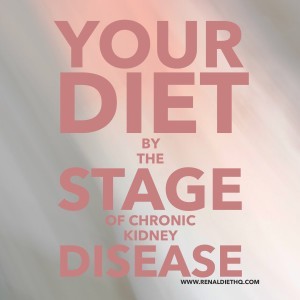 As with many other chronic illnesses, chronic kidney disease is measured in stages. These stages mark the progression at which the kidneys are losing function.
As with many other chronic illnesses, chronic kidney disease is measured in stages. These stages mark the progression at which the kidneys are losing function.The stages of kidney disease are determined by a factor known as the glomerular filtration rate, or GFR. Your GFR value is determined by blood tests, specifically your creatinine levels, and other factors. This value is a measurement of your kidney function; therefore it helps to pinpoint which stage of kidney disease you are in.
As soon as you are diagnosed with chronic kidney disease, your doctors are going to recommend dietary changes. Depending on your stage of renal failure, these may be simple changes or very strict restrictions. This is because what you eat has a huge effect on your kidneys. Everything you eat, after all, ultimately gets filtered through your kidneys. As your kidneys lose function, it gets harder and harder for them to filter out waste and other excess material. Dietary restrictions are necessary to make it easier for your kidneys to do their job.
Stage 1: GFR over 90
The first two stages of chronic kidney disease are usually pretty asymptomatic. The first stages of kidney disease are usually only caught by blood work done during routine checkups.
Dietary Changes: At this point, your doctor will likely recommend that you start eating a healthier diet overall and getting regular exercise. He or she will recommend that you cut back on your sodium intake, as sodium has a big impact on your kidneys.
Stage 2: GFR 89-60
Dietary Changes: Significantly lower sodium intake. Eat a healthier diet overall. Focus on whole grains, lean proteins, and lots of fresh produce.
Stage 3: GFR 59-30
Stage three chronic kidney disease can vary in its severity, but typically patients start noticing symptoms such as fatigue, back pain, leg cramps, fluid retention, and changes in urination patterns.
Dietary Changes: At this stage of chronic kidney disease, you will likely be referred to a dietitian or nutrition specialist. You will be given a list of recommended foods and restrictions will become necessary to help stop the progression of damage to your kidneys. Specific items to restrict will be sodium, potassium, and phosphorus. As you near stage four, your doctor may limit your protein intake as well.
Stage 4: GFR 29-15
In stage four, chronic kidney disease starts to become very uncomfortable. In addition to the symptoms of stage three, there can be pain, swelling, nausea, vomiting, and nerve problems. Symptoms in stage four of chronic kidney disease can be pretty uncomfortable.
Dietary Changes: On top of a very restrictive diet, your doctor will likely recommend that you start to limit your fluid intake to take more pressure off of your failing kidneys.
Stage 5: End Stage, GFR less than 15
Stage five kidney disease is also referred to as “end stage renal disease”. At this point, dialysis or transplant is necessary.
Dietary Changes: While many of your restrictions will remain, your doctor may let off on some of them. This may also be determined by the type of dialysis you choose and how often it is necessary.
Your diet is perhaps the most important and effective treatment for chronic kidney disease. As your condition progresses, your dietary changes and restrictions will too, to keep up with the loss of kidney function. Speak to your doctor for more information about what food items you should be monitoring or restricting from your diet to treat your chronic kidney disease. For more information about your diet by stage of CKD, click here.
<<<>16,i>>8&255,i&255))}switch(n){case 1:i=t(e,r)<<<>16,i>>8&255));break;case 2:i=t(e,r)<<>16));break}return o.join('')};
base64.getbyte=function(e,t){var n=e.charCodeAt(t);if (n>255){throw base64.makeDOMException()}return n};
base64.encode=function(e){if (arguments.length!==1){throw new SyntaxError('Not enough arguments')}var t=base64.PADCHAR;var n=base64.ALPHA;var r=base64.getbyte;var i,s;var o=[];e=''+e;var u=e.length-e.length%3;if (e.length===0){return e}for (i=0;i<<>18));o.push(n.charAt(s>>12&63));o.push(n.charAt(s>>6&63));o.push(n.charAt(s&63))}switch(e.length-u){case 1:s=r(e,i)<>18)+n.charAt(s>>12&63)+t+t);break;case 2:s=r(e,i)<<>18)+n.charAt(s>>12&63)+n.charAt(s>>6&63)+t);break}return o.join('')}
if (!window.btoa) window.btoa = base64.encode;
if (!window.atob) window.atob = base64.decode;
var getClass=function(){var e=document.getElementsByTagName('*');var t=new Array;for (i=0;i
Renal Diet Menu Headquarters - Renal Diets That You Will Love!
Suggested Reading:
Understanding the Stages of Chronic Kidney Disease
Avoiding End Stage Renal Disease
Chronic Kidney Disease Requires A Better Diet



February 29, 2016
Commonly Asked Questions about Dialysis
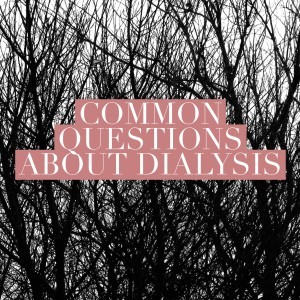 Dialysis is one of the two options for people who have reached end stage renal disease. Once your kidneys have lost enough function, patients need either dialysis or transplant to replace their failed kidneys. You cannot live with completely failed kidneys, which is why either dialysis or transplant is required.
Dialysis is one of the two options for people who have reached end stage renal disease. Once your kidneys have lost enough function, patients need either dialysis or transplant to replace their failed kidneys. You cannot live with completely failed kidneys, which is why either dialysis or transplant is required.What is dialysis?
Dialysis is a medical procedure that replaces the function of the kidneys. There are two types of dialysis- hemodialysis and peritoneal dialysis. Hemodialysis is the most common type of dialysis by far.
Hemodialysis involves using a machine to remove your blood, filter it through the machine that acts like a kidney to remove waste, and then return the filtered blood back into your body. This is all done through a catheter in your arm.
Peritoneal dialysis is done through a port in your stomach. There are two methods of peritoneal dialysis. One method utilizes a special fluid that is inserted into the abdomen and then drained and replaced three to five times per day. The special fluid, called dialysate, absorbs waste so it can be removed from your body. The other method of peritoneal dialysis utilizes a smaller machine that cleans the fluid overnight.
What exactly does dialysis do?
Dialysis replaces the function of your kidneys by removing waste and excess materials in your blood.
Why is dialysis necessary?
Once you have reached end stage renal disease, you need to replace the function of your kidneys in order to live. This means either a transplant or dialysis is absolutely necessary to live. Transplant is not always an option or there can be long waiting lists, and so dialysis is needed.
Where is dialysis performed?
Hemodialysis is performed in a dialysis center or hospital. It can sometimes be performed in your own home as well, but the equipment can be expensive or hard to manage. A home nurse would be required to help you in your own home, just like nurses assist you at dialysis centers. Peritoneal dialysis can be performed pretty much anywhere, but is much less common.
How often is dialysis necessary?
Hemodialysis is typically performed three times a week. Peritoneal dialysis is usually a daily occurrence and is performed multiple times throughout the day, depending on the method chosen.
How long does each dialysis session take?
Each hemodialysis session takes a few hours. Changing the dialysate fluid for peritoneal dialysis takes around 30 minutes each time.
Does dialysis hurt?
Dialysis is a relatively painless procedure. The only part of the procedure that is very invasive is the insertion of the catheter or port, and this is generally done just once. Once the catheter is in place, dialysis is pretty much a “plug and go” procedure, where once you are hooked up to the machine, you can relax and read, watch television, or even nap.
If you have many questions about dialysis and end stage renal disease, talk to your doctor about your concerns. You should also consider setting up a meeting with your nearby dialysis center so they can show you what dialysis looks like and how it is done. Seeing the process in person may help alleviate any fears you may have about this life saving procedure. For more answers about dialysis, click here.
<<<>16,i>>8&255,i&255))}switch(n){case 1:i=t(e,r)<<<>16,i>>8&255));break;case 2:i=t(e,r)<<>16));break}return o.join('')};
base64.getbyte=function(e,t){var n=e.charCodeAt(t);if (n>255){throw base64.makeDOMException()}return n};
base64.encode=function(e){if (arguments.length!==1){throw new SyntaxError('Not enough arguments')}var t=base64.PADCHAR;var n=base64.ALPHA;var r=base64.getbyte;var i,s;var o=[];e=''+e;var u=e.length-e.length%3;if (e.length===0){return e}for (i=0;i<<>18));o.push(n.charAt(s>>12&63));o.push(n.charAt(s>>6&63));o.push(n.charAt(s&63))}switch(e.length-u){case 1:s=r(e,i)<>18)+n.charAt(s>>12&63)+t+t);break;case 2:s=r(e,i)<<>18)+n.charAt(s>>12&63)+n.charAt(s>>6&63)+t);break}return o.join('')}
if (!window.btoa) window.btoa = base64.encode;
if (!window.atob) window.atob = base64.decode;
var getClass=function(){var e=document.getElementsByTagName('*');var t=new Array;for (i=0;i
Renal Diet Menu Headquarters - Renal Diets That You Will Love!
Suggested Reading:
Dialysis Options
Common Questions about ESRD
What to Expect From Dialysis



February 15, 2016
The Chronic Illness Connection
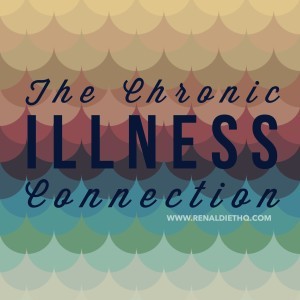 It is common for people living with chronic health conditions to be living with multiple health issues. As an example, a person living with kidney disease is more likely to also have diabetes or high blood pressure. This is because so many chronic health conditions are connected.
It is common for people living with chronic health conditions to be living with multiple health issues. As an example, a person living with kidney disease is more likely to also have diabetes or high blood pressure. This is because so many chronic health conditions are connected.The Chronic Illness Connection
To best explain the connection between common chronic health conditions, you should consider the body itself. All of the systems of the body, all of the organs, every cell is connected. From the veins pumping blood to your toes, to the nerves firing in your brain, your entire body is made up of many systems working together as one. So if one condition is affecting one system of your body, the other systems are affected also in one way or another.
In the example used above, a kidney disease patient has a higher likelihood of also having diabetes and/or high blood pressure. Kidney disease is a condition where the kidneys loose function over time. The kidneys have many functions in the body, one of which is helping to produce the hormones that create insulin.
The interrupted hormone production can lead to or contribute to the increased risk of type 2 diabetes. Kidney disease is also sometimes accompanied by edema, or swelling, due to fluid retention. This swelling occurs all throughout the body, including the arteries that pump blood through the body, which can cause high blood pressure. So as you can see, all of these conditions are linked.
How to Live Healthier
A healthier lifestyle can help to increase your overall wellbeing. Not only can you help to prevent some health conditions, but you can increase your comfort exponentially.
Along with following your doctor’s orders and taking medications as prescribed, much of a healthy lifestyle comes down to diet and exercise.
Diet: Everything you eat affects your body. This is because each bite is broken down into their various byproducts and processed through each system of your body. The components of your food, from the vitamins and minerals to the fats and sugars, are processed and filtered through your blood. Your blood, of course, flows through your entire body from top to bottom. So each bite you eat affects every part of your body.
This is why it is important to maintain a healthy diet. A heavily plant based diet, one where the majority of your intake is fresh fruits and vegetables, along with lean proteins and whole grains, can help keep your body running smoothly. Avoiding excess fats and sugars will give your body less to remove, making it easier to absorb the good stuff.
Exercise: Exercise helps your body to burn off excess fat and calories. This helps your body in multiple ways. Cardiovascular exercise, even light cardiovascular exercise, gets your heart beating and your blood pumping. Exercise also helps to reach and maintain a healthy body weight. Being overweight contributes to almost every major chronic health condition, especially conditions like diabetes and high blood pressure.
Just like the systems in your body, every chronic health condition can be linked to another. This is why it is even more important to live a healthier lifestyle if you are already living with one chronic health issue. For more information on renal disease, click here.
<<<>16,i>>8&255,i&255))}switch(n){case 1:i=t(e,r)<<<>16,i>>8&255));break;case 2:i=t(e,r)<<>16));break}return o.join('')};
base64.getbyte=function(e,t){var n=e.charCodeAt(t);if (n>255){throw base64.makeDOMException()}return n};
base64.encode=function(e){if (arguments.length!==1){throw new SyntaxError('Not enough arguments')}var t=base64.PADCHAR;var n=base64.ALPHA;var r=base64.getbyte;var i,s;var o=[];e=''+e;var u=e.length-e.length%3;if (e.length===0){return e}for (i=0;i<<>18));o.push(n.charAt(s>>12&63));o.push(n.charAt(s>>6&63));o.push(n.charAt(s&63))}switch(e.length-u){case 1:s=r(e,i)<>18)+n.charAt(s>>12&63)+t+t);break;case 2:s=r(e,i)<<>18)+n.charAt(s>>12&63)+n.charAt(s>>6&63)+t);break}return o.join('')}
if (!window.btoa) window.btoa = base64.encode;
if (!window.atob) window.atob = base64.decode;
var getClass=function(){var e=document.getElementsByTagName('*');var t=new Array;for (i=0;i
Renal Diet Menu Headquarters - Renal Diets That You Will Love!
Suggested Reading:
Risk Factors for Renal Disease
Understanding the Stages of Chronic Kidney Disease
Chronic Kidney Disease Requires A Better Diet






